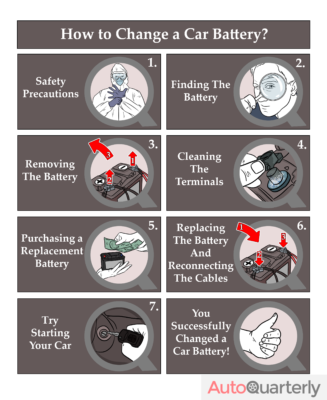Your car battery won’t last forever, even if you’ve cared for it perfectly. If your headlights are dimming, your car needs to be jump-started because the battery is dead, or the battery is over three years old, you should replace it. If unsure, you can always test it. While this may sound complicated, it’s actually a relatively easy and quick project that you can do yourself at home using just a handful of basic tools. Here, we show you how to change a car battery so that you can keep your vehicle in full running order.
- First Steps
- Safety Precautions
- Finding The Battery
- Removing The Battery
- Cleaning The Terminals
- Purchasing A Replacement Battery
- Replacing The Battery
- Reconnecting The Cables
- Finishing The Process
- What Should I Do If My Car Doesn’t Start After I Installed A New Battery?
- Should My Engine Be Left Running After I Change The Battery?
- My Car Has A Cover Over Its Battery – How Do I Take It Out?
- Will Changing My Car’s Battery Affect Its Mileage In The Future?
- Do I Have To Change My Car’s Battery Myself?
First Steps
Before you can replace your car battery you’ll need to remove the old one. You can do this by parking your vehicle on a flat surface within a secure space and switching off the vehicle. Whenever possible, you should avoid changing the battery at the roadside. It’s always best to find somewhere safe to do the job away from any sparks, traffic, water or open flames.
Engage the parking brake, turn off the vehicle and take the key out of the ignition so you can sure that no power will go to the car’s battery. A garage is one of the best places to change the battery, but if you choose this spot, ensure that the door remains open to keep the area ventilated properly. Remember that removing the battery is going to reset the alarm, navigation, radio and clock settings, so ensure you know the alarm code before getting started.
Safety Precautions
Put on some safety gear then pop open the hood of your car. Batteries contain a solution of sulfuric acid electrolytes, and this is extremely corrosive. It can burn you and produce hydrogen gas which is highly flammable, so wear safety goggles and gloves to ensure you’re well protected from harm. Remove any metal jewelry to ensure you don’t get an electric shock and choose old clothing as you may get greasy. Remember to prop up the hood with a stick or rod to stay safe.
Finding The Battery
You should look in the corner of your car’s engine bay to find the battery. It will be either close to the front bumper or the windshield on either the left or right of the vehicle. The battery box is a rectangular shape and will have two cables connected to it. In a newer vehicle, there may be a plastic cover over the battery that you need to remove. Be aware that some vehicles have their battery inside the trunk instead of the hood, so if in doubt, check your manual.
Removing The Battery
First, disconnect the negative cable and secure it using a cable tie. This will prevent an electrical short. You will recognize the negative terminal since it will usually be black and could have a “-“ sign close to it. Use a 7mm, 8mm, 10mm or 13mm wrench (depending on your vehicle) to loosen the negative cable clamp and then slide the cable off its terminal. Secure the cable with a cable tie onto the engine bay, avoiding any contact with metal items. Some battery terminals feature quick-release clamps. If yours does, you’ll need no tools to take the cables off the terminal.
Next, disconnect the positive cable then use a cable tie to secure it. Usually, this cable will be red and may have a “+” sign by it. There may be a plastic terminal cover that needs to be removed. Once it is, use a wrench to make the positive cable clamp loose. Then, take it off the terminal and secure the cable to the engine bay using a cable clamp.
Remember to ensure the negative and positive cables never touch each other, or that anything made from metal comes into contact with them, or a hazardous electrical short could occur.
Next, inspect the bracket which secures the battery in position. Remove the connectors holding the bracket and battery together. Do this by using a socket, socket wrench and extension bar. After removing the fasteners, take the battery out of its engine bay and put it down – preferably on a surface made of concrete if you can. Bear in mind that batteries can be heavy so you may need help to lift it.
Cleaning The Terminals
Once the battery has been removed, check the terminals to see if any corrosion is visible. This will look like a white, gray, blue or green powdery buildup. Use 100-grit sandpaper or an emery cloth to clean away the corrosion from the terminals but remember battery acid can burn you, so don’t get any on your clothes or skin.
Purchasing A Replacement Battery
You will need to choose the right battery to replace your existing one, so make sure you check which type you need for your individual car make and model. You will need to know the part number, dimensions and size of your old battery together with the make, model, year and engine size of your car. Remember to recycle your old battery and don’t throw it into the trash since it contains corrosive substances.
Replacing The Battery
Put your new battery into its battery tray then secure it onto the bracket. Reverse the same process used to remove your old battery from its bracket. Next, coat the terminals with a layer of lithium grease. This will help to guard against corrosion. Ensure you’ve oriented the battery in the same way as the previous one and check all the bracket fasteners are secure to prevent the battery from moving around or vibrating while you’re on the road. Don’t spray any lithium grease onto any other area of the engine block except the negative and positive terminals.
Reconnecting The Cables
First, undo the cable tie that secures the positive cable onto the engine bay, ensuring it doesn’t touch any metal items. Put the positive cable over the terminal then tighten it using a wrench. If your battery has a plastic terminal cover, put it down now. Next, repeat the process for the negative terminal. It’s vital that you carry out the procedure in this order to avoid accidentally completing the circuit and causing yourself or your vehicle harm.
Finishing The Process
Ensure that all tools have been removed from beneath the hood before closing it. Try starting your car – if you have followed these steps properly your car will start normally. You may need to enter your alarm code to make the electronic devices function properly. Once you have done this, reset the navigation system, radio, and clock, and you’re good to drive!
What Should I Do If My Car Doesn’t Start After I Installed A New Battery?
If you have followed all of these above steps properly and the connections have been properly tightened and your car is turning over but isn’t starting, the alternator, ignition or starter motor could be faulty. You should seek advice from a qualified automotive technician.
Should My Engine Be Left Running After I Change The Battery?
Once you’ve changed your car’s battery you should leave its engine running for a while. This will enable the battery to charge back up to its full capacity. Once the charge is complete, you can turn the engine off. If the car turns back on again, you’ve charged the battery sufficiently. If it doesn’t start, you’ll need to charge it some more.
My Car Has A Cover Over Its Battery – How Do I Take It Out?
If your car has a plastic cover over its battery that stops you from taking it out of the engine bay, you’ll need to remove the cover first. Look around it to see if you can spot any round little plugs – these are holding the cover down. Run your hands around the plastic cover too to ensure there are no small screws to remove before the cover can be taken off.
Will Changing My Car’s Battery Affect Its Mileage In The Future?
You don’t need to have any concerns about this process affecting its fuel mileage in the future. Batteries cannot impact on your vehicle’s fuel mileage. The only factors that can have a negative impact on your mileage are the kind of oil you’re using, whether you have regularly maintained your spark plugs, plug wires, and fuel filter, the type of octane you’re choosing, any performance parts that you’ve had fitted, and any fuel additives you’re choosing.
Do I Have To Change My Car’s Battery Myself?
If you read the steps outlined above, you’ll know how to change a car battery. However, that doesn’t mean that you’ll feel confident about doing the job yourself. Not everybody wants to tackle their own car maintenance, so if you’re worried about tackling your own battery replacement or you’d rather avoid spending the time and effort on the task yourself, you can simply take your vehicle to an auto service center or garage. A professional technician will easily be able to do the job for you and get you back on the road in no time.



